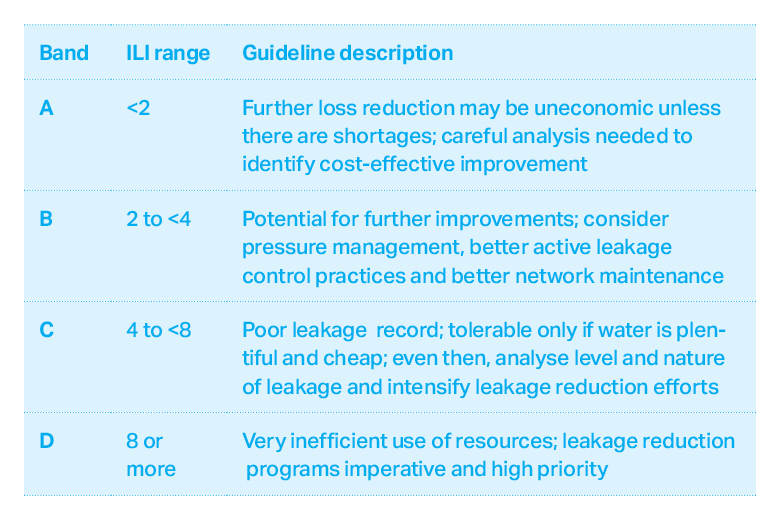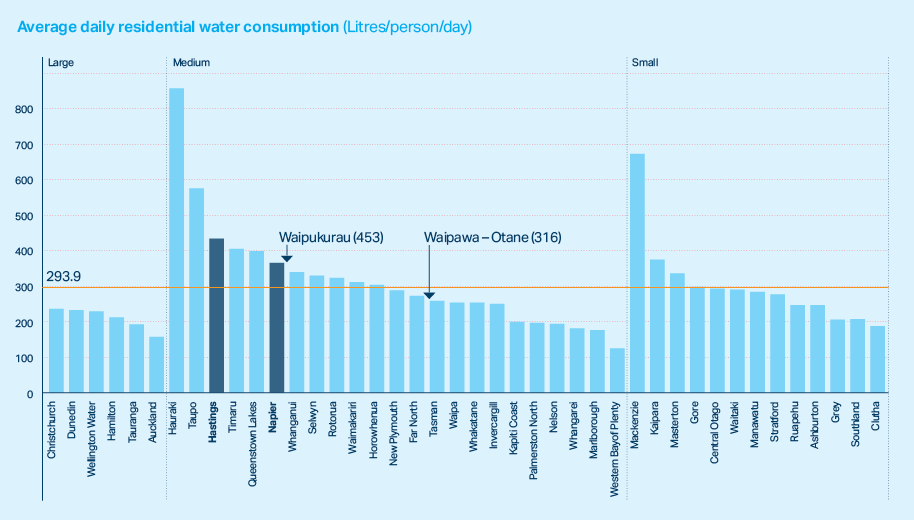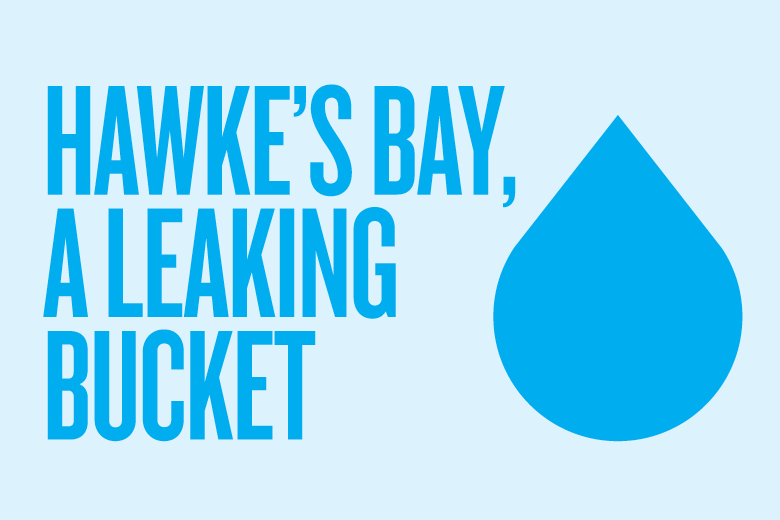[As published in May/June BayBuzz magazine.]
Hawke’s Bay is leaking like a sieve.
That really is the long and the short of this region’s water infrastructure situation.
According to the HB Regional Water Assessment, we use about 24 million cubic metres of water for reticulation systems serving our households, sportsgrounds, parks and industry.
It appears that 20% or more of this is leaking away.
Hence why the Hastings District Council, for instance, states that on a good day it aims “for no more than 20 per cent leakage’’ from its network.
Precisely where those leaks are and at what volume appears difficult for our councils to discern. In excusing themselves for letting this precious resource literally run down the drain, they will point you in the direction of the national figures. In other words, yeah, water is leaking out of our pipes by the bucketful, but so is everyone else’s.
It’s just that 14 councils across the country, miraculously, appear to be doing a better job at managing their water than others. Whangārei, Western Bay of Plenty, Nelson, Far North District Council, Hauraki, Selwyn, Kāpiti Coast, Tasman, Auckland, Tauranga, Christchurch, Whakatāne, Waipā and Central Otago have all installed residential meters.
Let’s isolate the Kāpiti Coast because the success of its water metering scheme sits in stark contrast with its neighbours in Wellington City.
Wellington is estimated to be losing 45% of its water through leaks.
Not only did Kāpiti reduce its volume of leaks by 90%, but the overall water usage in the district also dropped by 25%. That’s partly because in installing the meters, Kāpiti immediately identified 443 leaks in its infrastructure.
Different councils use different means to charge residents for water use, but the consistent theme among the fourteen is they all use less water and lose less water.
“Water is taken for granted in New Zealand’’ is the opening line of a Water New Zealand paper on the topic of water metering. The paper notes comments, made in 2009, by then-Ministry for the Environment natural systems policy manager Craig Mallett that “we can’t manage what we don’t measure.’’ That applies to catchments without water metering.
How do we rate?
The commonly used standard for comparison of water leakage is the Infrastructure Leakage Index (ILI). The ILI breaks water losses into four bands, from A to D. As you would expect, A is the best band of the four.

Hawke’s Bay’s councils fall into Band C. Napier, for instance, has an ILI number of 4.2 and Hastings 4.8. The higher the number, the greater the leaking.
Across the region, some infrastructure is in better repair than others. In Takapau, the estimated ILI number is 11.6, while Kairakau is 10.2. That’s very firmly in the D band. Waipukurau loses 699 litres per property per day, while Waipawa loses 607 L/prop/day.
Hawke’s Bay practices
In our region, the main pillar of our water conservation strategy is education. Most of you will have had a friendly reminder from your local authority over the years, suggesting you limit the use of garden sprinklers, otherwise you’ll be restricted to hand-held watering on alternate days. It’s a nice idea, which many people willingly acquiesce to, but it’s a band-aid.
The HDC says it attached 2,000 smart water meters to council tobies in the summer of 2022/23 to gain “an improved understanding of water use and leak information.’’
Largely, though, it appears as if HDC’s overall Water Conservation & Demand Management Strategy Policy is to hope we don’t leave the taps running all day.
“Since 2009, HDC has embarked on an education programme designed to raise the awareness of water usage within the Hastings supply areas,’’ the policy reads. “This programme involves a variety of approaches including signage and website information supported through a media campaign to reinforce HDC’s water conservation message aimed at modifying consumer behaviours.
“HDC’s website and other advertising mechanisms provide water saving tips and general water efficiency advice. They are used to promote water efficient appliances, efficient water practices, responsible garden care and to discourage wasteful use. This information also encourages the community to report any leaks to council.’’
As for the information gathered from the 2,000 smart meters installed in Hastings, Havelock North, Flaxmere, Bridge Pa and Paki Paki, that’s yet to be assessed.
“As you will have noted on the Hastings District Council water meter page, the meters are for monitoring leaks and to give a guide on water use,’’ an HDC spokesperson said.
“The 2023/24 assessment that will use the data from these meters will commence after 1 July and the information will be documented in the HDC Annual Report published later this year.
“Water leaks are an issue for every council. The water meter information is another tool to help identify whether we have an issue with below-ground leaks [noting that at-ground leaks are obvious] as well as identify leakage on private properties.
“Universal metering is not in council’s budget or Long-term Plan, however it is under consideration.’’
The Napier City Council (NCC) runs its supply through 471 kilometres of water mains and says its volume of leaks across that network is “considered high’’ on the ILI ranking. In real terms, NCC loses about 22% of its water.
Domestic water users in Napier are unmetered while domestic water users in Bay View are metered. All commercial users with high water usage and all industrial users are metered.
Like the HDC, the NCC’s appetite for household water meters appears minimal at a time when council rates rises are forecast for a decade to come.
“Water meters are a useful tool in managing water use,’’ Napier Mayor Kirsten Wise said.
“Although we have no immediate plans to instate them in Napier we have indicated that it’s something we could look at in the future. “We have to change behaviours and mindsets around water demand management. We have very high rates of water use in Napier.
“Not all water meters need to be linked to charging. They can be helpful for being actively aware of how much is being used. We do use water meters in some instances when we think there is a leak and we want to check the network.’’
Up in Wairoa, water infrastructure has been further compromised in Hawke’s Bay by Cyclone Gabrielle. Wairoa District Council (WDC) produces around three million litres of water per day. In 2020/21 and 2021/22, the percentage of water loss from the WDC networked reticulation system was 15% and 17 % respectively. “As a direct result of Cyclone Gabrielle, and infrastructural impacts following the cyclone, water loss increased to 44% in 2022/23,’’ WDC chief executive Kitea Tipuna said.
Steps are being taken – beyond a general consumer education programme – to combat the issue. “As per the 2023/24 Annual Plan, WDC is planning to renew a significant amount of water supply pipeline, with $637,000 budgeted for this work, which will help reduce water loss,’’ said Tipuna.
Central Hawke’s Bay has legendary water infrastructure problems.
“Water leaks are an issue for every council,’’ CHBDC chief executive Doug Tate said.
“The major driver for addressing leaks across our networks has been seeking to increase our renewal and capital investment across our drinking water supply and reticulation networks through our major investment programme #thebigwaterstory, established in 2017.
“We’ve been making major progress on this over the last five years. Since 2021 alone, we have installed 10.2 kilometres of new water pipeline across the network and installed 142 new valves. That is helping us to keep up with the rate of deterioration.’’
This work features prominently in the CHBDC’s new Three-Year Plan Consultation Document. The council has presented three potential Drinking Water and Wastewater Investment options to ratepayers, with its preferred one featuring capital expenditure of $54.9 million. “There is always more that can be invested and we acknowledge that the current model to deliver three waters is not financially sustainable,’’ said Tate.
Interestingly, the widespread installation of household water meters does appear to be up for real discussion in Central Hawke’s Bay.
“We currently meter our extraordinary [commercial] water users and some residential properties in Central Hawke’s Bay have water meters,’’ Tate said. “While there is budget provision outside of the first three years of the Three Year Plan 2024-2027 for metering, the elected council have not yet determined a policy position on universal water metering.
“This decision, which would include community consultation, would need to occur ahead of any decision to implement districtwide metering.’’
CHBDC budgets 300 cubic metres – or 300,000 litres – a year per household. If you use less than 300 cubic metres per year, your water rates will cover all costs and there will be no further charges. If you use more than 300 cubic metres, you will be invoiced on a user-pays basis.
HDC has a similar practice of charging $0.99 per cube for water supplied “over and above typical household consumption as defined in the HDC Ware Services Policy Manual. HDC does require meters on new builds.
Asked about water metering, Mayor Sandra Hazlehurst told Baybuzz,“We looked at water meters several years ago and found that it would cost $20 million, so we decided to spend the money on safe drinking water and storage facilities,’’ Hazlehurst said.
The cost of meters also has to be weighed up against the other projects HDC has on its plate, including the “overwhelming recovery demands for roads and bridges we have to prioritise for recovery,’’ said Hazlehurst.
For those reasons, the mayor says HDC can’t justify meters now, but will have to at some point. “We do have to have water metering because we do have to protect our precious water resources. It has to come. Water is a finite resource,’’ Hazlehurst said.
“New builds are easy,” she adds. “We’d have to figure out how to manage existing residences.”
And, as previously noted, while Mayor Kirsten Wise endorses it, water metering is outside her next year Three-Year frame of reference.
Meantime, however, the government has signalled that mandatory water metering might well be an element of its ‘Three Waters’ policy.
Residential water consumption
Water metering is an invaluable tool, but it is we individuals who consume the water in the first place. And in Hawke’s Bay, we consume a lot of it.

Without access to universal metering, Water New Zealand uses a broad estimate of how much water we need in New Zealand per person, per day of between 180 and 300 litres.
That figure in the United Kingdom is said by Water New Zealand to be 150 litres.
CHBDC says Ministry of Health guidelines indicate a household will need at least 274 cubic metres of water each year. As you can see from the chart above, our HB communities are well above that target.
Certainly civic education plays a role in conserving water, but there are regulatory measures to be considered as well. Metering with charges for excessive use, for starters. But direct conservation measures as well. For instance, a Bylaw adopted by CHBDC in 2021 requires a rainwater (retention) tank of minimum volume 3,000L for all new residential builds in urban areas. Rural areas, or places considered to be ‘outside of the area’ from potable water supplies continue to require a storage tank with minimum volume of 30,000L.
Where to?
The bottom line is that we need better pipes and better monitoring of the water flowing through them.
The HB Regional Water Assessment noted, water metering for urban users (nearly all irrigation, industrial and commercial uses are already metered) would be a key element of more effective water management across the region.
As the assessment identified, the benefits for urban water meters include:
• Identifies leaks;
• Increased awareness of actual water use;
• Enables volumetric charging;
• Reduces water use; and
• Avoids/defers capital expenditure of additional supply infrastructure, e.g., storage.
If we’re really serious about conserving water in our ‘water security’ focused region, this is the direction we must go.

